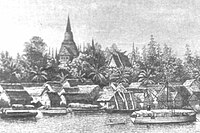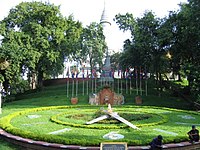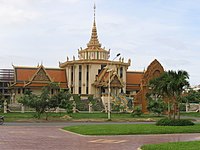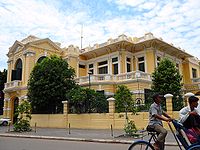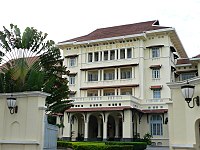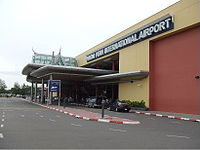Phnom Penh
From Wikipedia, the free encyclopedia
| Phnom Penh ភ្នំពេញ | |||
|---|---|---|---|
| — City — | |||
| Clockwise from top: Throne Hall inside the Royal Palace, Choeung Ek Memorial, The National Museum of Cambodia, Independence Monument,and Wat Phnom | |||
| |||
| Nickname(s): Pearl of Asia (pre-1960s) The Charming City | |||
| Coordinates: 11°33′N 104°55′E | |||
| Country | Cambodia | ||
| Province | Phnom Penh | ||
| Settled | 1372 | ||
| Became Capital | 1865 | ||
| Subdivisions | 8 districts (khans) | ||
| Government | |||
| - Type | Municipality | ||
| - Mayor & Governor | H.E. Keb Chutema កែប ជុគិមា | ||
| - Vice Governors | H.E. Than Sina, H.E. Map Sarin, H.E. Seng Tong | ||
| Area | |||
| - Total | 678.46 km2 (262 sq mi) | ||
| Elevation | 11.89 m (39 ft) | ||
| Population (2010)[1] | |||
| - Total | 1,501,725 | ||
| - Density | 2,213.4/km2 (5,732.8/sq mi) | ||
| Demonym | Phnom Penher | ||
| Time zone | Cambodia (UTC+7) | ||
| Area code(s) | +855 (023) | ||
| Website | Phnom Penh Website | ||
Phnom Penh (Khmer: ភ្នំពេញ, pronounced [pʰnum peːɲ] in Khmer and /pəˈnɒm ˈpɛn/ or /ˈnɒm ˈpɛn/ in English[2]) is the capital and largest city of Cambodia. Located on the banks of theMekong River, Phnom Penh has been the national capital since the French colonized Cambodia, and has grown to become the nation's center of economic and industrial activities, as well as the center of security, politics, economics, cultural heritage, and diplomacy of Cambodia.
Once known as the “Pearl of Asia”, it was considered one of the loveliest French-built cities in Indochina[3] in the 1920s. Phnom Penh, along with Siem Reap and Sihanoukville, are significant global and domestic tourist destinations for Cambodia. Founded in 1434, the city is noted for its beautiful and historical architecture and attractions. There are a number of surviving French colonial buildings scattered along the grand boulevards.
Situated on the banks of the Tonlé Sap, Mekong and Bassac rivers, the Phnom Penhmetropolitan area is home to more than 2 million of Cambodia’s population of over 14 million.[4] The city is the wealthiest and most populous city in Cambodia and is home to the country’s political hubedit]
Etymology
Phnom Penh takes its name from the present Wat Phnom (“Hill Temple”). Legend has it that in 1372, an old nun named Lady Penh went to fetch water in theMekong and found a dead Koki tree floating down the stream. Inside a hole of the Koki tree were four bronze and one stone Buddha statues.
Daun (Grandma) Penh brought the statues ashore and ordered people to pile up earth northeast of her house; she then used the Koki trunks to build a temple on the hill to house the five Buddha statues, and then named the temple after herself as Wat Phnom Daun Penh, which is now known as Wat Phnom, a small hill of 27 metres (89 ft) in height.
Phnom Penh was also previously known as Krong Chaktomuk (Khmer: ក្រុងចតុម្មុខ) meaning "City of Four Faces". This name refers to the junction where the Mekong, Bassac, and Tonle Sap rivers cross to form an “X” where the capital is situated. Krong Chaktomuk is an abbreviation of its ceremonial name which was given by King Ponhea Yat, which in full isKrong Chaktomuk Mongkol Sakal Kampuchea Thipadei Sereythor Inthabot Borei Roth Reach Seima Maha Nokor.
This ceremonial name is composed from Pali, and loosely translates as "The place of four rivers that gives the happiness and success ofKampuja Kingdom, the highest leader as well as impregnable city of the God Indra of the enormous Kingdom".[5]
[edit]History
Phnom Penh first became the capital of Cambodia afterPonhea Yat, king of the Khmer Empire, moved the capital fromAngkor Thom after it was captured by Siam a few years earlier. There is a stupa behind Wat Phnom that house the remains of Ponhea Yat and the royal family as well as the remaining Buddhist statues from the Angkorean era. There are also legends that tell how Phnom Penh was created in the 17th century by Japanese immigrants who settled on the outskirts of present-day Phnom Penh.[6]
Phnom Penh remained the royal capital for 73 years-from 1432 to 1505. It was abandoned for 360 years-from 1505 to 1865-by subsequent kings due to internal fighting between the royal pretenders. Later kings moved the capital several times and established their royal capitals at various locations in Tuol Basan (Srey Santhor),Pursat, Longvek, Lavear Em and Oudong.
It was not until 1866, under the reign of King Norodom I, that Phnom Penh became the permanent seat of government and capital of Cambodia, and also where the current Royal Palace was built. Beginning in 1870, the French Colonialists turned a riverside village into a city where they built hotels, schools, prisons, barracks, banks, public works offices, telegraph offices, law courts, and health services buildings. In 1872, the first glimpse of a modern city took shape when the colonial administration contracted a French contractor, Le Faucheur, to construct the first 300 concrete houses for sales and rentals to the Chinese traders. A commonly known building built by the French is Phsah Thmei.
By the 1920s, Phnom Penh was known as the Pearl of Asia, and over the next four decades Phnom Penh continued to experience rapid growth with the building of railways to Sihanoukville and the Pochentong International Airport (now Phnom Penh International Airport). Phnom Penh under the period of Sihanouk’s rule seen the expansion and construction of many modern infrastructures.[7]
During the Vietnam War, Cambodia was used as a base by the North Vietnamese Army and the Viet Cong, and thousands of refugees from across the country flooded the city to escape the fighting between their own government troops, the NVA/NLF, the South Vietnamese and its allies, and theKhmer Rouge. By 1975, the population was 3 million, the bulk of whom were refugees from the fighting.[8] The city fell to the Khmer Rouge on April 17, 1975. Most of its residents, including those who were wealthy and educated, were evacuated from the city and forced to do labour on rural farms as "new people".[9] Tuol Svay Prey High School was taken over by Pol Pot's forces and was turned into the S-21 prison camp, where Cambodians were detained and tortured. Pol Pot sought a return to an agrarian economy and therefore killed many people perceived as educated, "lazy", or political enemies. Many others starved to death as a result of failure of the agrarian society and the sale of Cambodia's rice to China in exchange for bullets and weaponry. The former high school is now theTuol Sleng Genocide Museum, where Khmer Rouge torture devices and photos of their victims are displayed. Choeung Ek (The Killing Fields), 15 kilometres (9 mi) away, where the Khmer Rouge marched prisoners from Tuol Sleng to be murdered and buried in shallow pits, is also now a memorial to those who were killed by the regime.
The Khmer Rouge were driven out of Phnom Penh by the Vietnamese in 1979,[10] and people began to return to the city. Vietnam is historically a state with which Cambodia has had many conflicts, therefore this liberation was and is viewed with mixed emotions by the Cambodians. A period of reconstruction began, spurred by the continuing stability of government, attracting new foreign investment and aid by countries including France, Australia, and Japan. Loans were made from the Asian Development Bank and the World Bank to reinstate a clean water supply, roads and other infrastructure. The 1998 Census put Phnom Penh's population at 862,000;[11] and the 2008 census was 1.3 million.[12]
[edit]Geography
Phnom Penh is located in the south-central region of Cambodia, and is fully surrounded by the Kandal Province. The municipality is situated on the banks of the Tonlé Sap, Mekong, and Bassac rivers. These rivers provide potential freshwater and other natural resources to the city. Phnom Penh and the surrounding areas consists of the typical wet plain area for Cambodia. Phnom Penh rises 11.89m or (39 ft) which causes problems for the city of potential flooding by the monsoon season which sometimes over flow the banks of the river.
The city, located at 11.55°N 104.91667°E (11°33' North, 104°55' East,[13]), covers an area of 678.46 square kilometres (262 sq mi), with some 11,401 hectares (28,172 acres) in the municipality and 26,106 hectares (64,509 acres) of roads. The agricultural land in the municipality amounts to 34.685 square kilometres (13 sq mi) with some 1.476 square kilometres (365 acres) under irrigation.
[edit]Climate
Phnom Penh has a tropical wet and dry climate. The climate is hot year-round with only minor variations. City temperatures range from 18° to 38 °C (64° to 100 °F) and experiences tropicalmonsoons. Southwest monsoons blow inland bringing moisture-laden winds from the Gulf of Thailandand Indian Ocean from May to October. The northeast monsoon ushers in the dry season, which lasts from November to March. The city experiences the heaviest precipitation from September to October with the driest period occurring from January to February.
The city has two distinct seasons. The rainy season, which runs from May to October, which temperatures can rise up to 40 °C (104 °F) around April and is generally accompanied with high humidity. The dry season lasts from November to April when temperatures can drop to 22 °C (72 °F). The best months to visit the city are November to January when temperatures and humidity are lower.
| [hide]Climate data for Phnom Penh | |||||||||||||
|---|---|---|---|---|---|---|---|---|---|---|---|---|---|
| Month | Jan | Feb | Mar | Apr | May | Jun | Jul | Aug | Sep | Oct | Nov | Dec | Year |
| Average high °C (°F) | 31.1 (88) | 32.8 (91) | 33.9 (93) | 35 (95) | 33.9 (93) | 32.8 (91) | 32.2 (90) | 32.2 (90) | 31.1 (88) | 30.6 (87) | 30 (86) | 30 (86) | 32.11 (89.8) |
| Average low °C (°F) | 21.7 (71) | 22.2 (72) | 23.3 (74) | 24.4 (76) | 24.4 (76) | 24.4 (76) | 24.4 (76) | 24.4 (76) | 24.4 (76) | 24.4 (76) | 23.3 (74) | 21.7 (71) | 23.61 (74.5) |
| Precipitation mm (inches) | 7.6 (0.30) | 10.2 (0.40) | 35.6 (1.40) | 78.7 (3.10) | 144.8 (5.70) | 147.3 (5.80) | 152.4 (6.00) | 154.9 (6.10) | 226.1 (8.90) | 251.5 (9.90) | 139.7 (5.50) | 43.2 (1.70) | 1,391.9 (54.80) |
| Source: weather.com[14] | |||||||||||||
[edit]Administration
Phnom Penh is a municipality standing at 678.46 square kilometres (261.95 sq mi) and is governed with a status that is equal to provinces of Cambodia. As such, it has a similar political structure to its provinces. The municipality is subdivided into 7 administrative divisions called Khans (districts) and of the 7 Khans, Dangkao, Meanchey and Russei Keo are considered the outskirts of the city. All Khans are under the governance of the Phnom Penh Municipality. The Khans are further subdivided into 76Sangkats (communes), and 637 Kroms.
The municipality is governed by the Governor who acts as the top executive of the city and manages the general affairs as well as overlooking the Municipal Military Police, Municipal Police and Bureau of Urban Affairs. Below the Governor is the First Vice Governor and 5 Vice Governors. The Chief of Cabinet who holds the same status as the Vice Governors, heads the Cabinet that consists of 8 Deputy Chiefs of Cabinet which in turn are in charge of the 27 Administrative Departments. Every khan (district) also has a head Chief. [5]
| List of Phnom Penh Administrative Districts | |||
|---|---|---|---|
| Name of district (khan) | Number of communes (sangkat) | Number of villages (phum) | |
| Chamkarmon | 12 sangkats | 95 kroms | |
| Dangkao | 15 sangkats | 143 kroms | |
| Daun Penh | 11 sangkats | 134 kroms | |
| Meanchey | 8 sangkats | 30 kroms | |
| Prampi Makara | 8 sangkats | 33 kroms | |
| Russei Keo | 12 sangkats | 59 kroms | |
| Sen Sok | |||
| Tuol Kork | 10 sangkats | 143 kroms | |
[edit]Demographics
As of 2008, Phnom Penh had a population of 2,009,264 people, with a total population density of 5,358 inhabitants per square kilometre (13,877/sq mi) in a 375 km2 (145 sq mi) city area. The population growth in the city is 3.92%.
Phnom Penh is mostly inhabited by Cambodians (or Khmers) - they represent 90% of the population of the city. There are large minorities of Chinese, Vietnamese, and other small ethnic groups who are Thai, Budong, Mnong Preh, Kuy, Chong, and Chams. The state religion isTheravada Buddhism, more than 90% of the people in Phnom Penh are Buddhists with the Chams practicing Islam over the years since 1993, there has also been an increase in the practice of Christianity which was practically wiped out after 1975 when the Khmer Rouge took over. English and French are widely used in the city, but the official language is Khmer.
[edit]Economy
Phnom Penh's is Cambodia's economic center as it accounts for a large portion of the Cambodian economy. Double-digit economic growth rates in recent years have triggered an economic boom in Phnom Penh, with new hotels, restaurants, bars, high rises, and residential buildings springing up around the city.
The main economy is based on commercial interests such as garments, trading, and small and medium enterprises. In the past few years the property business has been booming as real estate is now getting very expensive in the city. Tourism is also a major contributor in the capital as more shopping and commercial centers open, making Phnom Penh one of the major tourist destinations in the country along with Siem Reap and Sihanoukville.
The US$2.6 billion new urban development, Camko City, is meant to bolster the city landscape. The Bureau of Urban Affairs of Phnom Penh Municipality has plans to expand and construct new infrastructure to accommodate the growing population and economy. High rise buildings will be constructed at the entrance of the city and near the lakes and riverbanks. Furthermore, new roads, canals, and a railway system will be used to connect Camko City and Phnom Penh.[15]
Other projects include:
- Grand Phnom Penh International City
- De Castle Royal Condominium[16]
- International Finance Complex (Phnom Penh, Cambodia)
- Gold Tower 42
- OCIC Tower
- River Palace[17]
With booming economic growth seen since the 1990s, new shops have opened as well as western-style malls such as Sorya Shopping Center and the new Sovanna Shopping Center. Two international franchises have also opened up in Phnom Penh. Dairy Queen has already opened up inside Phnom Penh International Airport and Kentucky Fried Chicken (KFC) has opened up a restaurant on Monivong Boulevard and plans to open more soon.[18] The same company that opened up KFC in Cambodia has now obtained franchise rights to open Pizza Hut in the country.[19] In addition, Swensen's ice cream restaurants was also opened in Sorya Shopping Center.
The Central market Phsar Thmei is a major tourist hot spot. The four wings of the yellow colored market are teeming with numerous stalls selling gold and silver jewellery, antique coins, clothing, clocks, flowers, food, fabrics and shoes. Phsar Thmei is also going under a major renovation project, with fresh paint on the exterior and interior, and the creation of newer stalls.
Cambodia Angkor Air has its head office in Phnom Penh.[20]
[edit]Education
The Royal University of Phnom Penh (RUPP) is the oldest and largest institution of higher educationin Cambodia. As of 2008, the university has over 10,000 students across three campuses, and offers a wide range of high-quality courses within the Faculty of Science, the Faculty of Social Sciences and Humanities, and the Institute of Foreign Languages (IFL). There are about fifty higher institutions in Cambodia, most of which have no small campuses. Several international charities, like A New Day Cambodia, operate independent educational facilities in addition to public schools for students.
The Buddhist Institute was founded on May 12, 1930 and is the principal state Buddhist institution in Cambodia.
[edit]Culture
Phnom Penh is notable for Ka tieu Phnom Penh, its variation on rice-noodle soup. Phnom Penh also has its own dialect of Khmer. Speakers of the Phnom Penh dialect often elide syllables, which has earned it the reputation for being lazy speech. Phnom Penh is also known for its influence on New Khmer Architecture. The city is the most modern of Cambodian cities. It is both the economic and cultural center of Cambodia.
The two most visited museums in the city are the National Museum, which is the country's leading historical and archaeological museum, and Tuol Sleng Genocide Museum, a former Khmer Rouge prison.
Chaul Chnam Thmey 13–15 April
Phnom Penh gets lively for Cambodian New Year, with increasing numbers of tourists getting in on the action. This is usually the warmest part of the year, water gets thrown around adding to the party atmosphere along with dancing and music. The date changes year-by-year but this holiday always lasts three days or often stretches into the weekend. This festival marks the turn of the year based on the ancient Khmer calendar and also marks the end of the harvest done during the year
Water Festival November
Main article: Bon Om Thook
The largest annual festival in Phnom Penh, this lively gathering celebrates the reversing of the flow of the Tonlé Sap river. The holiday lasts three days as people flood into the city to enjoy the fireworks, colorful boat races, live concerts, eating and partying. The boat racing dates back to ancient times marking the strengths of the powerful Khmer marine forces during the Khmer Empire.
On the 22nd November 2010 at least 348 people were crushed to death in a bridge stampede at the festival.[21]
Pchum Ben 7-9 October
Pchum Ben is a very important aspect of Cambodian culture. It may be translated as "gathering together" to make offerings and is a time of reunion, commemoration, express love and appreciation for one's ancestors. By offering food and good karma to those possibly trapped in the spirit world, living relatives help assuage their misery and guide them back into the cycle of reincarnation
[edit]Cityscape and Architecture
The oldest structure is the Wat Phnom from the founding days of the city, constructed in 1373. The main tourist attractions are the Royal Palace with the Silver Pagoda, which dates to the mid-19th century; the National Museum, constructed during the French colonial era in the late 19th century in the classical Khmer style hosts a vast collection of Khmer antiquities; the Independence Monument(Khmer: Vimean Akareach), although modern from the 1950s, is also constructed in the ancient Khmer style.
The French, who were the colonial masters from the 19th century to the 1940s, also left their mark, with various colonial villas, French churches, boulevards, and the Art deco market Phsar Thom Thmei. A notable landmark of the colonial era is the Hotel Le Royal.
Starting with independence from the French in the 1950s and lasting until the era of the Khmer Rouge in the 1970s, Phnom Penh underwent tremendous growth as the capital city of a newly independent country. King Sihanouk was eager to present a new style of architecture and thus invigorate the process of nation building. A new golden era of architecture took off, with various projects and young Khmer architects, often educated in France, given opportunities to design and construct. This new movement was called "New Khmer Architecture" and was often characterised by a fusion of Bauhaus, European post-modern architecture, and traditional elements from Angkor. The most prominent architect was Vann Molyvann, who was nominated chief national architect by the king himself in 1956. Molyvann created landmark buildings such as the Preah Suramarit National Theatre and the Council of Ministers building, other architects helped construct the newly founded Royal Khmer University, the Institute of Foreign Languages and the National Sports Centre. With the growth of the upper and entrepreneurial middle class, new suburbs were built in the 1950s and 60's.
Although these buildings survived the Khmer Rouge era and the civil war, today they are under threat due to economic development and financial speculation. Villas and gardens from that era are being destroyed and redeveloped to make place for bigger structures. The landmark National Theatre by Molyvann was ripped down in 2008.[22] A movement is rising in Cambodia to preserve this modernist heritage. Old villas are sometimes being converted into boutique hotels, such as the Knai Bang Chatt.
Monuments and memorials to the genocide during the Khmer Rouge era in the 1970s are the Tuol Sleng Genocide Museum (a former high school used as a concentration camp) and on the outskirt of the city the Choeung Ek Genocide Center. The Cambodia-Vietnam Friendship Monument was commissioned by the Vietnamese communists as symbol of Khmer-Vietnamese "friendship" during the late 1970s following the liberation of Cambodia from the Khmer Rouge.
[edit]Newspapers and magazines
[edit]Dailies
[edit]Khmer
- Sralagn' Khmer
- Chakraval Daily
- Kampuchea Thmei Daily
- Kampuchea Thnai Nes (Cambodia Today)
- Kanychok Sangkhum
- Koh Santepheap (Island of Peace)
- Moneaksekar Khmer (Khmer Conscience) - Published by the Sam Rainsy Party.
- Rasmei Kampuchea (Light of Kampuchea) - Cambodia's largest daily, it circulates about 18,000 copies.
- Samleng Yuvachun (Voice of Khmer Youth)
- Udomkate Khmer (Khmer Ideal)
- Wat Phnom Daily
[edit]English
- Phnom Penh Post, a daily English-language newspaper published in Phnom Penh.
- The Cambodia Daily, an English-language daily newspaper.
[edit]Chinese
- 《柬華日報》(Jianhua Daily), a daily Chinese-language newspaper published in Phnom Penh.
- 《星洲日報》(Sinchew Daily), a Chinese-language daily newspaper.
- 《華商日報》(Huashang Daily), a Chinese-language daily newspaper.
- 《新柬埔寨》(New Cambodia), a Chinese-language daily newspaper.
[edit]Magazines
- AsiaLIFE Guide Phnom Penh, a monthly English-language lifestyle magazine published in Phnom Penh.
- Pocket Guide Cambodia publishes four separate guides aimed at English-speaking residents and visitors. Titles include Drinking & Dining, Out & About, After Dark, Door 2 Door as well as one Khmer-language guide called Sabay Sabay targeting the emerging young professional marketplace
[edit]French newspapers
- Cambodge Soir a weekly French-language newspaper published in Phnom Penh.
[edit]Sport
Main article: Sport in Cambodia
The martial arts of Bokator, Pradal Serey (Khmer kick boxing) and Khmer traditional wrestling have venues in Phnom Penh watched by dedicated spectators. Cambodia has increasingly become involved in modern sports over the last 30 years. As with the rest of the country, football and themartial arts are particularly popular.
The most prominent of venues in the city is the Phnom Penh National Olympic Stadium with a capacity of 50,000. Built in 1964, it is home to the Cambodian national football team, although the country never hosted the Olympic Games. Noted clubs include Phnom Penh Empire, Khemara andMilitary Police.
Olympic Stadium is the largest sports center in the Phnom Penh District. Volleyball, basketball, and tai-kwon-do games are often hosted at the stadium. The National Sports Centre of Cambodia is famous for hosting swimming, boxing, and volleyball competitions.
[edit]Transport
Phnom Penh International Airport is the second-largest and second-busiest airport in Cambodia after Angkor International Airport in Siem Reap. It is located 7 kilometres (4.3 mi) west of central Phnom Penh. Taxis, pick-ups, and minibuses leave the city for destinations all over the country, but are fast losing ground to cheaper and more comfortable buses. Phnom Penh also has a rail service.
Cambodia's national flag carrier, Cambodia Angkor Air, launched in 2009, is headquartered in Phnom Penh and has its main hub there, with an additional hub at the Angkor International Airport.[20] Budget flights from Kuala Lumpur, Malaysia to Phnom Penh are operated by AirAsia, a regional low-cost carrier.
Air France announced October 20th 2010, that it will begin to serve Phnom Penh from Paris-Charles de Gaulle starting March 27th 2011.[23]
There are numerous bus companies, including Phnom Penh Public Transport and GST Express, running services to most provincial capitals, including Sihanoukville, Kampong Chhnang, Udong andTakéo. Phnom Penh Sorya Transport Co. offers bus travel to several provincial destinations along the National Routes and to Ho Chi Minh City. Motorcycles and bicycles are popular forms of travel in the city.
Although the city is 290 kilometres (180 mi) from the sea, it is home to Cambodia's main freshwater port, a major port on the Mekong River valley, and it is linked to the South China Sea via a channel of the Mekong delta in Vietnam.
Local means of public transportation within the city include the cycle rickshaw, known in Khmer as "cyclo", and motorcycle taxis known as "tuk-tuk." Private forms of transportation include bicycles and automobiles.
[edit]Highways
As the capital of Cambodia, a number of National Highways connect the city with various parts of the country:
| National Highway | Code | Length | Origin | Terminal | |
|---|---|---|---|---|---|
| National Highway 1 | 10001 | 167.10 km | 103.83 mi | Phnom Penh | Vietnamese Border |
| National Highway 2 | 10002 | 120.60 km | 74.94 mi | Phnom Penh | Vietnamese Border |
| National Highway 3 | 10003 | 202.00 km | 125.52 mi | Phnom Penh | Sihanoukville |
| National Highway 4 | 10004 | 226.00 km | 140.43 mi | Phnom Penh | Sihanoukville |
| National Highway 5 | 10005 | 407.45 km | 253.18 mi | Phnom Penh | Thai Border |
| National Highway 6 | 10006 | 416.00 km | 258.49 mi | Phnom Penh | Banteay Meanchey |
| National Highway 7 | 10007 | 509.17 km | 316.38 mi | Phnom Penh | Lao Border |
[edit]Notable people
- François Chau (born 1959), actor
- Yim Guechse (born 1946), poet and author
- Patricia Hy-Boulais (born 1965), former professional tennis player
- Vann Molyvann (born 1926), architect
- Vann Nath (born 1946), painter
- Rithy Panh (born 1964), film director
- Sam Rainsy (born 1949), politician
- Mu Sochua (born 1954), politician
- Norodom Ranariddh (born 1944), politician
- Norodom Sihamoni (born 1953), king of Cambodia since 2004
- Norodom Sihanouk (born 1922), king of Cambodia until 2004
- Loung Ung (born 1970), author
[edit]Sister cities
 Long Beach, California, USA
Long Beach, California, USA Lowell, Massachusetts, USA
Lowell, Massachusetts, USA Providence, Rhode Island, USA
Providence, Rhode Island, USA Savannakhet, Laos
Savannakhet, Laos Vientiane, Laos
Vientiane, Laos Mandalay, Myanmar
Mandalay, Myanmar Busan, South Korea
Busan, South Korea Incheon, South Korea
Incheon, South Korea Ho Chi Minh City, Vietnam
Ho Chi Minh City, Vietnam Hanoi, Vietnam
Hanoi, Vietnam Cần Thơ, Vietnam
Cần Thơ, Vietnam Lam Dong, Vietnam
Lam Dong, Vietnam Shanghai, China
Shanghai, China Tianjin, China
Tianjin, China Kunming, Yunnan, China
Kunming, Yunnan, China





